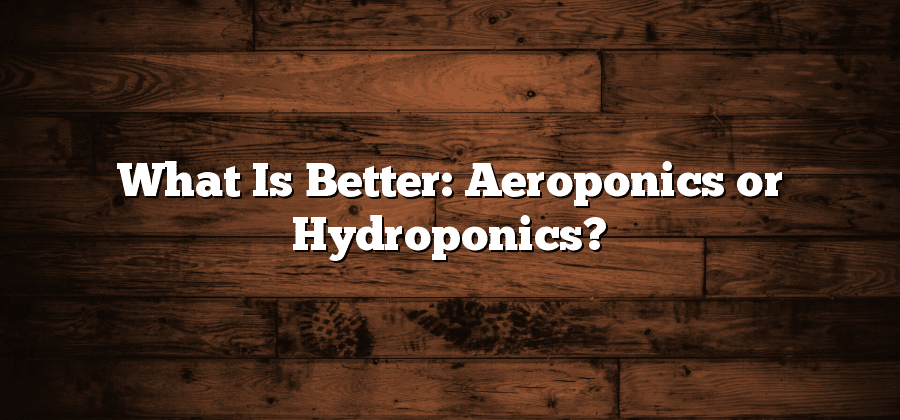Advantages of Aeroponics over Hydroponics
Aeroponics, a modern cultivation technique, offers several advantages over the traditional hydroponics method. Firstly, aeroponics allows for increased oxygenation and nutrient uptake by the plant roots. Unlike hydroponics, aeroponics suspends the plant’s roots in air and exposes them to a fine mist of nutrient-rich water. This unique approach promotes faster growth, stronger root development, and ultimately, higher yields.
Secondly, aeroponics requires less water compared to hydroponics. As the plant roots are exposed to a mist rather than submerged in a nutrient solution, water usage is significantly reduced. This not only benefits water conservation efforts but also results in lower costs for growers. Additionally, the reduced water usage contributes to a decrease in potential diseases caused by stagnant water, providing a healthier environment for plants to thrive.
In conclusion, aeroponics presents noteworthy advantages over hydroponics, including enhanced nutrient absorption and reduced water consumption. By adopting this innovative technique, growers can optimize their crop yields while minimizing their environmental impact. However, it is important to thoroughly assess the specific needs of different plant species and consider the associated costs before implementing aeroponics on a larger scale.
Disadvantages of Aeroponics compared to Hydroponics
Disadvantages of Aeroponics compared to Hydroponics:
One significant disadvantage of aeroponics compared to hydroponics is the complexity of the system. Aeroponic systems require advanced knowledge and expertise to set up and maintain properly. The precise control needed for misting and nutrient delivery can be challenging to achieve, especially for beginners or those with limited experience in agriculture. This complexity not only increases the initial investment in terms of time and money but also poses a higher risk of system failure if not managed correctly.
Another drawback is the potential for higher energy costs. Aeroponic systems rely on continuous misting to deliver nutrients to the roots, which requires energy to operate the misting mechanisms. This constant misting can contribute to increased energy consumption compared to hydroponic systems that may only need recirculating pumps. Additionally, aeroponic systems often require more frequent monitoring and adjustment to maintain optimal conditions, leading to further energy usage. These additional energy requirements can add up over time, potentially affecting the overall cost-effectiveness of aeroponics compared to hydroponics.
Key Differences between Aeroponics and Hydroponics
Aeroponics and hydroponics are two popular methods of indoor gardening that offer distinct advantages and differences. One key difference between aeroponics and hydroponics lies in the way plants acquire nutrients. In aeroponics, plants are suspended in the air, with their roots exposed to a fine mist of nutrient-rich water. This allows for greater absorption of nutrients and supports rapid growth. On the other hand, hydroponics involves growing plants in water enriched with nutrients, providing a constant supply to the roots. This allows for efficient nutrient uptake and promotes healthy plant development.
Another notable difference between aeroponics and hydroponics is the use of growing media. In aeroponics, no growing medium is required since the plants are suspended in air, reducing the risk of disease and pest infestations. On the contrary, hydroponics often requires the use of a growing medium such as clay pellets or rockwool to support the plants’ root systems and maintain nutrient uptake. This growing medium can introduce a potential risk of pests or diseases, warranting careful monitoring and management.
Environmental Impact of Aeroponics and Hydroponics
Aeroponics and hydroponics both offer unique advantages when it comes to reducing the environmental impact of traditional agriculture. One of the key benefits of both systems is the significant reduction in water usage. Unlike traditional farming methods that often result in water waste due to runoff, aeroponics and hydroponics use water more efficiently by recirculating it through the system. This not only conserves water resources but also reduces the risk of contaminating nearby water sources with harmful chemicals or fertilizers.
Another environmental advantage of aeroponics and hydroponics is their ability to minimize the need for pesticides and herbicides. In traditional farming, these chemicals are often heavily used to combat pests and weeds, leading to negative effects on soil health and biodiversity. However, with aeroponics and hydroponics, the enclosed and controlled environments allow for better pest and weed management without relying on harmful chemicals. This not only protects the ecosystem but also eliminates the risk of pesticide residue in the final crop.
Cost Analysis: Aeroponics vs. Hydroponics
Aeroponics and hydroponics are two modern methods of cultivation that have gained popularity due to their efficient use of resources and ability to produce high-yield crops in controlled environments. When considering the cost analysis between these two techniques, it becomes evident that each method has its own set of advantages and disadvantages.
One major advantage of aeroponics is its potential to significantly reduce water usage compared to hydroponics. In aeroponics, plants are grown without a soil or water medium, allowing for precise control and minimal wastage. This reduced water consumption directly translates to cost savings, especially in regions where water scarcity is a concern. Additionally, the aeroponic system requires less space, which can lead to reduced land costs or increased production per square meter, further enhancing its cost-effectiveness.






